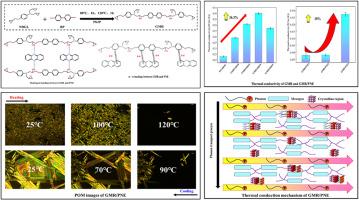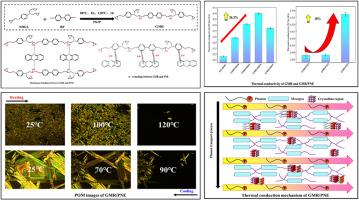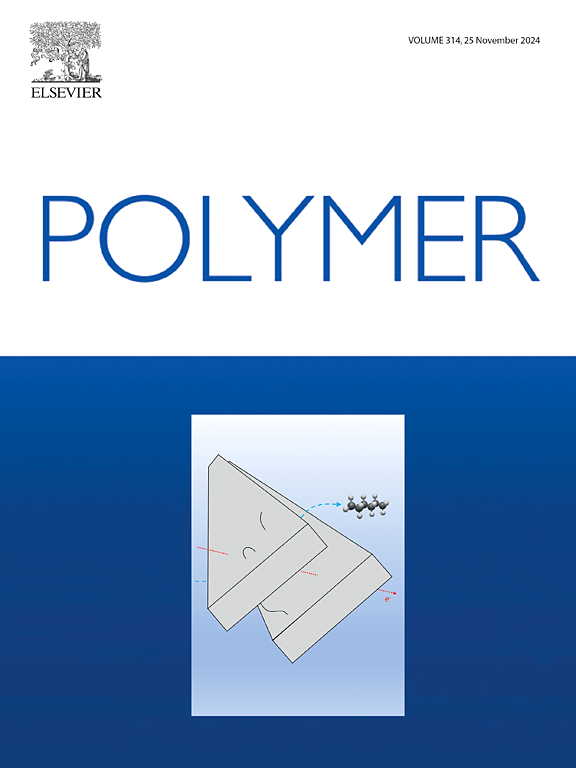联苯介形结构与有机晶体酚嗪在改善环氧树脂内在导热性方面的协同作用
IF 4.1
2区 化学
Q2 POLYMER SCIENCE
引用次数: 0
摘要
环氧树脂固有的低本征导热率严重限制了其潜在应用,使其难以满足能源、电气和电子技术日益增长的需求。液晶环氧树脂被广泛用于提高环氧树脂的本征导热率,但受制于其复杂的分子结构设计和合成过程。本研究通过开环聚合(ROP)将 4,4'-二羟基联苯的刚性基团引入环氧树脂主链,改变环氧树脂的分子结构。联苯基团的引入提高了分子结构的有序性,并在分子间形成氢键,从而进一步增强了分子内声子的传输。接枝改性环氧树脂(GMR)在 DDM 固化后的导热系数为 0.30 W-m-1-K-1。在 GMR 基体中加入有机结晶酚嗪(PNE)后,PNE 固有的强结晶行为可加速 GMR 中刚性基团的规整排列,促进 GMR/PNE 的成核和结晶过程。DDM 固化后,GMR/PNE 的导热系数可达 0.33 W-m-1-K-1。这是传统环氧树脂导热系数(0.2 W-m-1-K-1)的 165%。这项研究将为提高聚合物材料的固有热导率提供一种新方法。本文章由计算机程序翻译,如有差异,请以英文原文为准。


Synergy between biphenyl mesomorphic structure and organic crystal phenazine for improving the intrinsic thermal conductivity of epoxy
The inherent low intrinsic thermal conductivity of epoxy resin severely restricts its potential application, making it difficult to meet the growing demand of energy, electrical and electronic technologies. The liquid crystal epoxy resin, which is wildly employed to improve the intrinsic thermal conductivity of epoxy resin, is constrained by its complex molecular structure design and synthesis procedures. In this work, the rigid group of 4,4′-dihydroxybiphenyl was introduced into the main chain of epoxy resin by ring-opening polymerization (ROP) to change the molecular structure of epoxy resin. The introduction of biphenyl groups enhances the orderliness of molecular structure and forms hydrogen bonds between molecules, which further enhances the transport of intramolecular phonons. The thermal conductivity of the graft modified epoxy resin (GMR) after DDM curing is 0.30 W m−1 K−1. After adding of organic crystal phenazine (PNE) to the GMR matrix, the inherent strong crystallization behaviors of PNE can accelerate the regularity arrangement of rigid groups in GMR, and promote the nucleation and crystallization process of GMR/PNE. The thermal conductivity of GMR/PNE after DDM curing can reach 0.33 W m−1 K−1. It is 165 % of the thermal conductivity of traditional epoxy resin, which is 0.2 W m−1 K−1. This study will provide a new method to improve the intrinsic thermal conductivity of polymer materials.
求助全文
通过发布文献求助,成功后即可免费获取论文全文。
去求助
来源期刊

Polymer
化学-高分子科学
CiteScore
7.90
自引率
8.70%
发文量
959
审稿时长
32 days
期刊介绍:
Polymer is an interdisciplinary journal dedicated to publishing innovative and significant advances in Polymer Physics, Chemistry and Technology. We welcome submissions on polymer hybrids, nanocomposites, characterisation and self-assembly. Polymer also publishes work on the technological application of polymers in energy and optoelectronics.
The main scope is covered but not limited to the following core areas:
Polymer Materials
Nanocomposites and hybrid nanomaterials
Polymer blends, films, fibres, networks and porous materials
Physical Characterization
Characterisation, modelling and simulation* of molecular and materials properties in bulk, solution, and thin films
Polymer Engineering
Advanced multiscale processing methods
Polymer Synthesis, Modification and Self-assembly
Including designer polymer architectures, mechanisms and kinetics, and supramolecular polymerization
Technological Applications
Polymers for energy generation and storage
Polymer membranes for separation technology
Polymers for opto- and microelectronics.
 求助内容:
求助内容: 应助结果提醒方式:
应助结果提醒方式:


